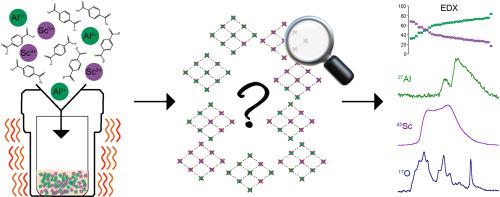使用固态核磁共振光谱表征无序(Al,Sc)-MIL-53的多核方法
IF 4.7
3区 材料科学
Q1 CHEMISTRY, APPLIED
引用次数: 0
摘要
采用DMF溶剂热法合成了一系列新型混合金属(Al,Sc)-MIL-53 mof。这些材料已经使用固态核磁共振光谱、x射线衍射、电子显微镜和能量色散x射线光谱的组合进行了表征。采用13C - MAS核磁共振光谱对呼吸行为进行了跟踪,结果表明,混合金属mof在两个端元上表现出不同的孔隙形式。用核磁共振17O谱分析了骨架中阳离子的分布。17O的自然丰度较低(0.038%),需要在合理的时间尺度上进行同位素富集以获得光谱,但富集试剂的高成本需要一种成本低且原子效率高的方法。用合成后蒸法对材料进行富集,富集骨架中的阳离子分布接近随机。27Al和45Sc核磁共振光谱提供了框架降解和杂质(氧化铝基材料和小孔MOF Sc2(BDC)3)在任何加热(即在煅烧、脱水或富集期间)形成的证据,导致富集的混合金属框架具有非常相似的成分(70 - 77% Al存在)。需要进一步的工作来克服所遇到的一些合成挑战,但是在客体分子存在或外部条件变化的情况下定制混合金属MOF的呼吸响应的可能性为未来提供了有趣的可能性。本文章由计算机程序翻译,如有差异,请以英文原文为准。

A multinuclear approach to characterising disordered (Al,Sc)-MIL-53 using solid-state NMR spectroscopy
A series of new mixed-metal (Al,Sc)-MIL-53 MOFs has been synthesised solvothermally using DMF. The materials have been characterised using a combination of solid-state NMR spectroscopy, X-ray diffraction, electron microscopy, and energy dispersive X-ray spectroscopy. The breathing behaviour was followed using 13C MAS NMR spectroscopy and showed that the mixed-metal MOFs exhibited different pore forms to the two end members. The cation distribution in the framework was investigated using 17O NMR spectroscopy. The low natural abundance of 17O (0.038 %) requires isotopic enrichment for spectra to be acquired on a reasonable timescale, but the high cost of enriched reagents necessitates a cost-effective and atom-efficient approach. Materials were enriched using post-synthetic steaming and the cation distribution in the enriched frameworks was shown to be close to random. Evidence for framework degradation and the formation of impurities (an alumina-based material and the small-pore MOF Sc2(BDC)3) upon any heating (i.e., during calcination, dehydration or enrichment) was provided from 27Al and 45Sc NMR spectroscopy, leading to the enriched mixed-metal frameworks having very similar compositions (with 70–77 % Al present). Further work would be required to overcome some of the synthetic challenges encountered, but the possibility of tailoring the breathing response of a mixed-metal MOF in the presence of a guest molecule or with changes in external conditions offers interesting possibilities for the future.
求助全文
通过发布文献求助,成功后即可免费获取论文全文。
去求助
来源期刊

Microporous and Mesoporous Materials
化学-材料科学:综合
CiteScore
10.70
自引率
5.80%
发文量
649
审稿时长
26 days
期刊介绍:
Microporous and Mesoporous Materials covers novel and significant aspects of porous solids classified as either microporous (pore size up to 2 nm) or mesoporous (pore size 2 to 50 nm). The porosity should have a specific impact on the material properties or application. Typical examples are zeolites and zeolite-like materials, pillared materials, clathrasils and clathrates, carbon molecular sieves, ordered mesoporous materials, organic/inorganic porous hybrid materials, or porous metal oxides. Both natural and synthetic porous materials are within the scope of the journal.
Topics which are particularly of interest include:
All aspects of natural microporous and mesoporous solids
The synthesis of crystalline or amorphous porous materials
The physico-chemical characterization of microporous and mesoporous solids, especially spectroscopic and microscopic
The modification of microporous and mesoporous solids, for example by ion exchange or solid-state reactions
All topics related to diffusion of mobile species in the pores of microporous and mesoporous materials
Adsorption (and other separation techniques) using microporous or mesoporous adsorbents
Catalysis by microporous and mesoporous materials
Host/guest interactions
Theoretical chemistry and modelling of host/guest interactions
All topics related to the application of microporous and mesoporous materials in industrial catalysis, separation technology, environmental protection, electrochemistry, membranes, sensors, optical devices, etc.
 求助内容:
求助内容: 应助结果提醒方式:
应助结果提醒方式:


